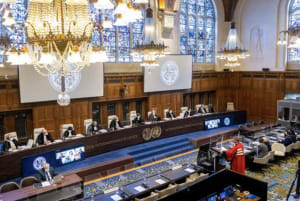Byzantine-era Christian psalm written as prayer to Jesus uncovered in Judean Desert
Greek inscription based on Psalm 86:1-2

Hebrew University archaeologists announced the discovery of a rare Koine Greek inscription at the Hyrcania fortress in the Judean wilderness.
The inscription, based on Psalm 86, was written as a prayer to Jesus.
The inscription was discovered on a stone, written in red paint. The stone was lying on the floor of a building that was allegedly part of a Byzantine monastery.
The archaeological team, led by Hebrew University’s Dr. Oren Gutfeld and Michal Haber, recognized the writing as Koine Greek, the same form that was used to write the New Testament.
Dr. Avner Ecker of Bar-Ilan University, an expert epigraphist, was asked to decipher it.
Ecker recognized the text as a quotation from Psalm 86:1-2, which in the original reads, “Hear me, Lord, and answer me, for I am poor and needy. Guard my life, for I am faithful to you.”
The text they discovered was written in the form of a prayer to Jesus, which reads:
† Ἰ(η)σοῦ Χ(ριστ)ὲ
φύλαξ<ο>ν με ὅτι
[π]τ<ω>χὸς (καὶ)
[π]έν[ης] <εἰ>μὶ <ἐ>γώ
† Jesus Christ
guard me for
poor and
needy am I
“This psalm holds a special place in the Masoretic [traditional Hebrew] text as a designated prayer and is notably one of the most frequently recited psalms in Christian liturgy," Ecker explained. "Thus, the monk drew a graffito of a cross onto the wall, accompanied by a prayer with which he was very familiar.”
Ecker analyzed the epigraphic style, along with several grammatical errors and determined that the inscription was made in the first half of the 6th century A.D. by a native speaker of a Semitic language.
“These minor errors indicate that the priest was not a native Greek speaker, but likely someone from the region who was raised speaking a Semitic language,” he explained.
The site was originally built as a fortress during the Hasmonean period, in the late 2nd or early 1st century B.C., and named after John Hyrcanus, according to the team. It was later expanded by Herod the Great, serving as one of his desert fortresses like Masada and Herodium.

The site was later resettled by monks during the Byzantine period in 492 A.D. as part of the desert monastic movement.
The site had never been previously excavated in such a “methodological, academic archaeological excavation”. The last archaeological work at the site was in the 1950s by a Belgian archaeologist when the site was controlled by Jordan.
The Hebrew University-led excavation was joined by teams from Carson-Newman University and the American Veterans Archaeological Recovery, which hoped to protect the archaeological finds from antiquities looters, who have become more active in recent years.
The site directors Gutfeld and Haber addressed the ongoing concern for looters and thanked the local authorities for their support.
“We are aware that our excavations will draw the attention of looters. The problem persists; it was here before us and will likely continue after us, underscoring the need for academic excavation – particularly in such a sensitive site as Hyrcania, though this is just one example. We are simply trying to stay a few steps ahead,” Gutfeld and Haber said in a statement.

The All Israel News Staff is a team of journalists in Israel.





